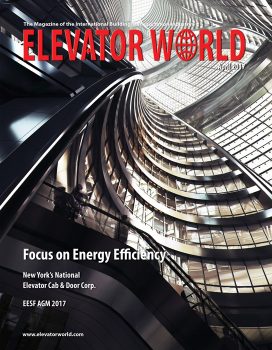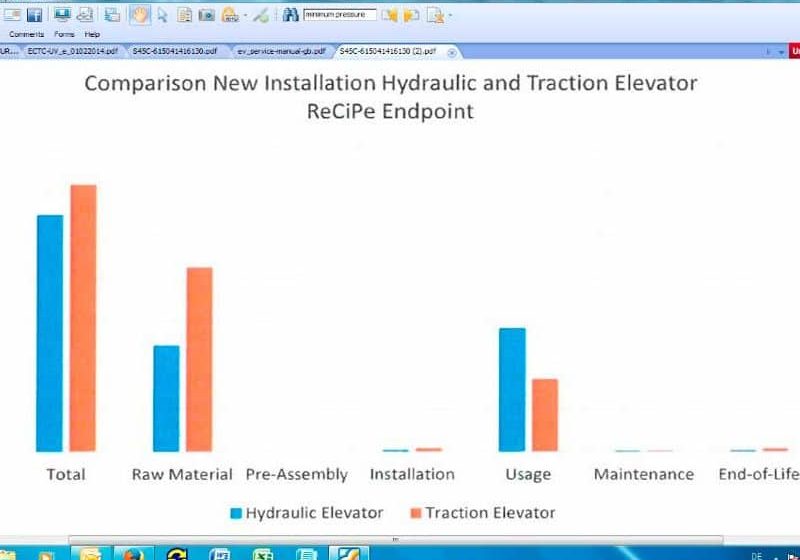Savings can be achieved by utilizing certain systems.
The aim of this report is to quantify and detail the improvements achieved when a lift’s drive-control equipment has been upgraded. In this study, we paid special attention to the elements deemed to have a higher impact on energy consumption, namely the drive controller, hoist motor and existence or lack of gearing. To carry out valid and comparable performance benchmarking, an independent and reliable data-acquisition system was required. Consequently, elevator consultancy Whitfield Rose Pty. Ltd. of Cremorne, Australia, in collaboration with software company iRMP Pty. Ltd., developed an integrated energy consumption, energy condition and lift performance data-acquisition system.
Electrical energy efficiency is of maximum importance today. Since the creation of the National Electricity Market and the deregulation of electricity markets in Australia, most nonresidential electricity customers are able to choose their energy provider and, in most cases, the tariff applied and the way this demand is billed. Often, larger commercial customers are billed according to the active energy consumed and the level of apparent energy with which the supplier needs to provide them. More economically efficient and environmentally sustainable power consumption has become increasingly significant in recent years, and the upgrading of obsolete electrical equipment has been a fundamental factor to achieve it.
The average energy consumption of a vertical-transportation (VT) system comprises approximately 10% of a typical building’s base load, and the energy-use efficiency achieved after drive-system modernization is quite significant.
The introduction of variable-frequency AC permanent-magnet (PM) drive technology has enabled significant reduction in the net energy consumption of elevator systems. It has also boosted the quality of the power load with an improvement in power factor, reflected harmonics and, consequently, the reduction in apparent power usage, thereby reducing the need for power-factor correction.
It is important to bear in mind that VT systems are not just products that can be easily compared, but whole engineered systems with mostly unique characteristics.
The improvements achieved vary, depending on the original equipment, and the brand and type of the new drive system installed. We have identified an average of almost a 40% decrease in active energy consumption and up to a 70% decrease in apparent energy consumption.
Australia’s main energy consumption building rating systems’ (National Australian Built Environment Rating System, Property Condition Assessment, Green Building Council of Australia, Building Sustainability Index, etc.) approach to lift energy consumption is to consider this power usage within the base load of the building, not as individual items that can be assessed and improved. This means that, although the improvement of energy consumption can be difficult to quantify, it can definitely help boost a building’s ratings (therefore favoring tenant attraction and retention).
The energy consumed by an elevator system is highly variable, with short time intervals and numerous starting current surges with the potential to regenerate. It depends on numerous factors, including rated speed, acceleration rates, rated load, roping system, traffic pattern, car-to-counterweight ratio and type of drive. This presents a challenge when analyzing total energy consumption. The drive system of a lift has been found to have the highest impact on energy efficiency.
Most previously published studies, including the international standard on ISO/DIS 25745-1 Energy Performance of Lifts, Escalators and Moving Walks Part 1 and the Building Code of Australia published by the Australian Building Codes Board, have reflected on energy use based only on active power (measured in kilowatt hours) consumption. However, because power usage can be measured and billed in both active power (kWh) and apparent power (measured in kilovolts-Ampere/hour) depending on the customer’s consumption, energy provider and location, we incorporated the apparent power measurement into our report.
Load-Adjusted Power Factor: How VT Systems Impact Power Demand
While preparing this study, we realized we had to address a peculiarity of power-factor measurement. Power factor is the ratio of active power to apparent power and represents how effectively electrical energy is being used. As VT systems include dynamic loads, as well as static loads (both mechanical and electrical), the power-factor static measurement may not accurately reflect the impact of the power demand in the distribution system. Unrepresentative poor power-factor values can be related to small low-current reactive loads that have a low power factor but would not impact any infrastructure considerations that might arise from poor power-factor values at higher loads.
In order to quantify the potential impact of power-factor values, the load-adjusted absolute power-factor calculation was developed to plot the power-factor measurement based on the proportion of the maximum load being drawn at the time. The load-adjusted power-factor values are also given in absolute values, so that power factor values are always positive to avoid further confusion.
Data Acquisition: the Importance of Correct Benchmarking
While obtaining data, we discovered some sites had existing power meters that only measured active energy (kWh) consumed in two quadrants, but not the power factor, apparent energy or regenerated energy. We also encountered meters from different manufacturers providing difficult-to-interpret data formats. Information on the number of lifts in service and/or actual activity was also variable and, in some cases, nonexistent, which can lead to unexplained discrepancies in the information gathered for review. Existing client-generated data was found to be of limited availability and inconsistent in format, accuracy and relevance. The need to consistently benchmark all the different sites analyzed, as well as gather data in a similar way through all the different types of sites, became evident.
After careful analysis and consideration, Whitfield Rose decided to use CVM-NRG96 four-quadrant meters. The reporting and system interaction has been managed remotely through the iRMP intranet web portal. This system is capable of accurately measuring sites with very different setups, from sites with only one lift to a full campus setup. The system provides verifiable data, including all lift performance activity, usage, energy consumption, power condition, regeneration, harmonic distortion and the like, over extended periods (up to 10 years) suitable for direct comparison.
Report Methodology
This report presents the results of analyzing the data collected over a six-year period from 40 different projects in Victoria, New South Wales, South Australia, Western Australia and New Zealand. The analysis included 230 lifts divided into 83 elevator groups.
Since developing the system, we have been able to accurately collect and report on lift power consumption and performance, analyzing data samples as small as 1 min. or as considerable as up to three years, while maintaining data storage capacity of up to 10 years. A data sample is recorded every 30 s., and a report can be generated at 1-min. intervals. When choosing the sample periods with the data to be analyzed, care has been taken so samples show consistency when compared to larger samples under the same circumstances regarding site, number of lifts in operation, availability, etc.
In this study, each site report includes a description of the number of lifts per elevator group and the levels served. In addition, they specify the power control system, both before and after modifications. Each report includes a comparison on speed, acceleration rate and load.
Additionally, valuable performance indicators such as system demand (number of calls, door openings and runs), average waiting times, time to answer 95% of calls and total lift runs have been examined.
We compared the peak currents operating within the system, the active energy use (total usage and per 100 runs), the apparent energy (total and per 100 runs) and the regenerative energy produced (both active and apparent). In our study, and because our purpose was to compare different performance and efficiency parameters after modernizations, we used an empirical method of analysis, which implies using real data collected onsite, rather than mathematical models and simulations. Furthermore, we measured total lift energy demand, including both travel and ancillary energy consumption (which encompasses the energy consumed by the car light, fans, alarm systems, visual display units, etc.). Data that could not be verified under the same circumstances (building occupancy, transport patterns, number of elevators in operation and lift usage) or that appeared unrealistic or incomplete were disregarded.
The modifications on drive equipment have been unique to each site, depending on particular requirements and existing conditions. It is important to bear in mind that VT systems are not just products that can be easily compared, but whole engineered systems with mostly unique characteristics. We resolved to summarize the upgrades in the following categories:
- SCD/silicon-controlled rectifier (SCR) to static DC with third-party nonproprietary pulse-width modulation (PWM)
- SCD/SCR to static DC (Schindler 12-pulse drive)
- Motor-generator DC to static DC with PWM
- Motor-generator DC to variable-frequency AC (VFAC) PM
- SCD/SCR to VFAC
- SCD/SCR to VFAC PM
- AC to VFAC
- AC to VFAC PM
Conclusion
We identified a large decrease in apparent energy consumption after drive-control equipment upgrades in every monitored site. This improvement in efficiency has been most significant when variable-frequency drives with PM motor technology have been introduced.
In most cases, the decrease in active energy consumption has also been substantial. When obsolete DC motors have been maintained while upgrading drive-control equipment, we observed an improvement in the power factor of the system, therefore reducing the consumption of apparent energy. Unfortunately, in these cases, the decrease in active energy consumption was not always as considerable.
Although there has been a significant shift toward energy-efficient buildings, VT systems seem to have been left out of all considerations. The energy consumed by heating, ventilation and air-conditioning and lighting systems has decreased dramatically, mostly due to technological developments and a close scrutiny and control from different authorities. The result of such an improvement on efficiency has been that the energy consumed by VT systems now represents a higher percentage of the overall building energy consumption.
We are pleased to see that, despite this situation (where the efficiency of lifts and escalators has not yet been regulated by any authority), different stakeholders are taking a positive approach toward energy efficiency. We would like to challenge professional bodies and property industry stakeholders to inquire into energy efficiency in VT systems from a more independent frame of reference.
Glossary of Terms
Types of Drive Equipment
- Motor generator (DC): Also known as the Ward Leonard Drive System, it is one of the oldest types of elevator drive systems still in use today. It consists of an AC motor rotating at a constant speed supplying the DC lift motor and offers a smooth speed control and consistent torque, although some power loss exists in the conversion from AC to DC. There is significant power consumption (approximately 35%) while the lift is idle due to the motor-generator running uninterruptedly. This drive system has a low efficiency rating, approximately 70%.
- DC static SCD/SCR: Electronic circuits are used to convert the 50-Hz AC power to DC so it can be used by the lift motor. The losses originated in the conversion are similar to motor-generator (DC) systems, although DC SCR drives do not consume any energy while the lift is idle. This drive system has an efficiency rating of around 80-85%.
- AC direct: These drive systems eliminate the need of AC to DC conversion, therefore increasing efficiency. They are asynchronous motors, so there are some power losses due to inductive slippage. They can be either one or two speed, and their efficiency rates around 90%.
- VFAC drives: Also known as variable-speed drives, they control the speed and power output by modulating the frequency and amplitude of the power supply. Although their efficiency improves on that of direct AC drives, the losses due to inductive slippage still exist.
- VFAC PM: VFAC drives can be equipped withrare-earth neodymium or samarium magnets, therefore creating a synchronous motor and improving the efficiency of the drives. There are significant savings due to the absence of magnet excitation losses. At the moment, this technology is regarded as the most efficient available in the market with a rating close to 98%.
- VFAC to PWM DC: This drive system utilizes the prevalent VFAC technology to drive older DC machines. As its name suggests, PWM speed control works by driving the motor with a series of on/off pulses and varying the duty cycle while keeping the frequency constant. The power applied to the motor can be controlled by varying the width of these applied pulses, thereby varying the average DC voltage applied to the motors’ terminals. The speed of the motor can be controlled by changing or modulating the timing of these pulses.
Performance Indication
Average waiting time: Average period of time from when a passenger either registers a landing call or joins the queue, until the responding lift begins to open its doors at the boarding floor. Notes that:
- The passenger waiting time continues if a passenger does not enter the responding lift, e.g., because the lift is full.
- The passenger waiting time is zero if the responding lift doors are open when the passenger arrives.
- If a passenger may register a call before arriving at the lift lobby, waiting time may be divided into two components: walking time (time to reach the lobby and standing time (time waiting in the lobby).
Energy Measurement
Active power is the rate of energy conversion in theresistive components of an electrical circuit with respectto time, measured in watts (W).
Reactive power is the rate of energy conversion in theinductive/capacitive elements of an electrical circuit withrespect to time, measured in volts-ampere reactive(VAR).
Apparent power is the vector summation of the realand reactive power, therefore taking into account theangle of difference between current and voltage, itrepresents the total power usage and its expressed in voltsampere (VA).
The power factor is defined as the ratio of activepower over apparent power. It represents how effectivelyelectrical energy is consumed. The closer a power factor isto unity, the most efficient the system.
References
[1] C. Bloomfield, H Chen & P. Bannister. “Lift Energy Use in Australian Office Buildings and Hotels,” EXERGY Australia Pty. Ltd., September 2011.
[2] CVM-NRG96 Series(circutor.com/en/products/measurement-and-control/fixed-power-analyzers/power-analyzers/cvm-nrg96-series-detail).
[3] ISO: ISO 25745-1:2012 — Energy Performance of Lifts, Escalators and Moving Walks — Part 1: Energy Measurement and Verification, Energy Measurement and Conformance, 2008.
[4] CIBSE Guide D: 2010. Transportation Systems in Buildings, 2010.
[5] C. Patrão, J. Fong, L. Rivet & A. de Almeida, “E4 Project: Energy Efficient Elevators and Escalators,” 2010.
[6] H. Yetiş, H. Boztepeli, Y. Yaşa & E. Meşe, “Comparative Design of Direct Drive PM Synchronous Motors in Gearless Elevator Systems,” Yildiz Technical University, October 2013.
[7] Mopidevi Raghava, M. Gopi & Chand Naik. “Comparative Study of Recent Advancements in Regenerative Drives in Elevator Systems,” Andhra University College of Engineering, Department of Electrical Engineering.
[8] MCE Technical Publications. AC Motor Controls for Elevators, (Section 17), 2004.
[9] Norman Disney & Young. Power Factor Correlation Evaluation Report. September 2002.
[10] Sachs, Harvey M. “Opportunities for Elevator Efficiency Improvements,” American Council for an Energy-Efficient Economy, April 2005.
[11] Al-Sharif, Lufti. “Lift Energy Consumption General Overview 1974 to 2001,” April 2004.
Get more of Elevator World. Sign up for our free e-newsletter.










